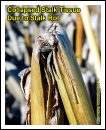

![]() ven though the current USDA corn production estimate for
Indiana is remarkably optimistic (http://www.nass.usda.gov/in/pressrel/de081203.txt),
many growers recognize that individual fields or areas within fields have been
struggling against multiple stresses throughout the season. Problems resulting
from stress in 2003 include root damage and lower leaf death due to soggy
soils, leaf canopy yellowing and death due to nitrogen deficiency resulting
from soggy soils, stunted root and canopy development due to excessively dry
soil moisture conditions, limited crop canopy photosynthesis due to frequent
cloudy or hazy days, and root damage from corn rootworm larva feeding.
ven though the current USDA corn production estimate for
Indiana is remarkably optimistic (http://www.nass.usda.gov/in/pressrel/de081203.txt),
many growers recognize that individual fields or areas within fields have been
struggling against multiple stresses throughout the season. Problems resulting
from stress in 2003 include root damage and lower leaf death due to soggy
soils, leaf canopy yellowing and death due to nitrogen deficiency resulting
from soggy soils, stunted root and canopy development due to excessively dry
soil moisture conditions, limited crop canopy photosynthesis due to frequent
cloudy or hazy days, and root damage from corn rootworm larva feeding.
 Fields or
areas within fields that have suffered one or more of these stresses will be
stressed further during the grain filling period as the photosynthetic factory
tries to keep up with the physiological demands of the developing ears. In some
severe situations, plants that are unable to keep up with the demand, due to
less than healthy root systems or crop canopies, will resort to cannibalizing
stored carbohydrate reserves in the lower stalk tissue and remobilizing those
reserves to the developing ears.
Fields or
areas within fields that have suffered one or more of these stresses will be
stressed further during the grain filling period as the photosynthetic factory
tries to keep up with the physiological demands of the developing ears. In some
severe situations, plants that are unable to keep up with the demand, due to
less than healthy root systems or crop canopies, will resort to cannibalizing
stored carbohydrate reserves in the lower stalk tissue and remobilizing those
reserves to the developing ears.
Such remobilization of stored carbohydrates from lower stalk tissue causes an overall deterioration of lower stalk integrity and strength. More importantly, as carbohydrate concentrations decrease in the lower stalk or root tissues, their resistance to the soil complex of root- and stalk-rotting organisms also decreases.
Beginning in late August or early September, growers should begin regular inspections of suspect fields that have endured multiple stresses this year and monitor the general health of the lower stalk and roots of plants. Stalk health in such fields further stressed by excessively dry soil conditions during grain filling will be particularly suspect.
 The simplest diagnostic
technique is to push stalks away from you as you walk down rows of corn and see
whether they collapse and break or “spring back” to a vertical
position. Easily broken plants signal either significant cannibalization of
lower stalk tissue or development of stalk rot. In either case, such fields are
prime candidates for stalk lodging concerns prior to harvest.
The simplest diagnostic
technique is to push stalks away from you as you walk down rows of corn and see
whether they collapse and break or “spring back” to a vertical
position. Easily broken plants signal either significant cannibalization of
lower stalk tissue or development of stalk rot. In either case, such fields are
prime candidates for stalk lodging concerns prior to harvest.
Pinching lower stalk internodes between your fingers can identify lesser degrees of stalk health concerns. If the internodes “give way” or collapse easily, that is also a signal that stalk health has been compromised. Split such stalks in half and inspect the interior for obvious disease symptoms.
 Root health can be
monitored first by attempting to pull plants out of the soil with your hands.
If this can be done easily, chances are that root health has been compromised
and the field is at risk of root lodging if severe windstorms occur prior to
harvest. If plants do not pull easily, then dig a few plants, wash the soil
away from the root system, and inspect the roots for discoloration (red,
purple, brown) that could indicate early root rot development.
Root health can be
monitored first by attempting to pull plants out of the soil with your hands.
If this can be done easily, chances are that root health has been compromised
and the field is at risk of root lodging if severe windstorms occur prior to
harvest. If plants do not pull easily, then dig a few plants, wash the soil
away from the root system, and inspect the roots for discoloration (red,
purple, brown) that could indicate early root rot development.
If fields are identified that are clearly high risk for root or stalk lodging prior to harvest, then schedule these fields for earlier than anticipated harvest to minimize the risk and consequences of severe lodging relative to potential mechanical harvest losses.